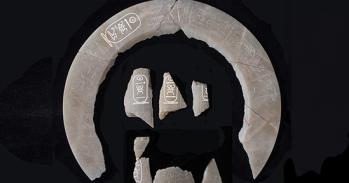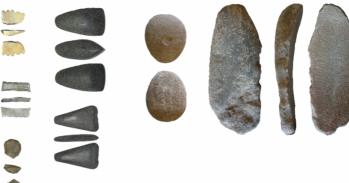
The identity of the winner of the 1880 Epsom Derby – the classic race to be run today - was famously disputed. Now analysis of DNA from the bones of historic horses has solved the mystery conclusively - and has confirmed the authenticity of the skeleton of one of the most famous stallions of all time.
The identity of the winner of the 1880 Epsom Derby – the classic race to be run today - was famously disputed. Now analysis of DNA from the bones of historic horses has solved the mystery conclusively - and has confirmed the authenticity of the skeleton of one of the most famous stallions of all time.
The purpose of the research was to develop tools that will help us understand the genetic history of the Thoroughbred horse and discover when certain genetic diseases entered the gene pool.
Dr Mim Bower
A team of researchers examining DNA extracted from the skeletons of historic horses in order to throw light on the origin of diseases found in modern horses have, in the course of their work, solved some of the mysteries that have long puzzled the horse-racing world.
The researchers' meticulous analysis answers the question of which of two horses actually won the Epsom Derby of 1880, revealing that the winner was running under the name of another horse. The same study has also led to the authentication of the 220-year-old skeleton of Eclipse, a legendary name in racing worldwide.
The project – published in the current issue of the journal Archaeometry – involved not just laboratory work to analyse the DNA contained in bones, hair and blood of 300 living Thoroughbred horses but also an examination of historic archives held in Cambridge University Library and close scrutiny of some of the most iconic paintings of horses.
The research project was led jointly by Dr Mim Bower of the McDonald Institute for Archaeological Research, University of Cambridge, who is an expert in the domestication of horses in pre-history, and a team from the Royal Veterinary College, including members of the Structure and Motion Group.
“The purpose of the research was to develop tools that will help us understand the genetic history of the Thoroughbred horse – and, in particular, to discover when certain catastrophic genetic diseases might have entered the gene pool,” said Dr Bower. “Knowledge of the history of these diseases will help us in improving the health of living racehorses.”
The Epsom Derby, to be run today, is one of the great classics of British racing. In the race of June 1880, a horse named Bend Or crossed the finishing line a whisker ahead of his rival, Robert the Devil. Celebrations turned sour when the owners of Robert the Devil claimed that Bend Or was running under the wrong name and was in fact a horse called Tadcaster. They argued that the two had been confused as yearlings - and that Robert the Devil was therefore the bona fide winner.
Bend Or and Tadcaster came from the Duke of Westminster’s Eaton Stud in Cheshire. With the same sire but out of two different dams, the three-year-olds looked strikingly similar – though the dam of the horse running in the Derby as Bend Or came from a lineage that had never won a race and the dam of the horse known as Tadcaster came from a winning line.
At a stewards’ inquiry the owners of the two horses – who had long been arch enemies - argued their cases. The inquiry found for the owners of Bend Or who went on to stand at stud and, on the basis of his Derby win, made the Duke of Westminster a small fortune. In a twist worthy of a Dick Francis thriller, one of the stud grooms who had handled the two horses as youngsters was reported to have confessed on his deathbed that the two animals had been confused – but he had been dismissed by the Duke of Westminster so his word was doubted.
Samples of DNA taken from the skeleton of Bend Or, which is archived in the Natural History Museum, were shown to match that of the living relatives of Tadcaster, proving almost without doubt that the horse running under the name Bend Or in the Derby of 1880 was indeed Tadcaster.
The same team of researchers have also looked at the DNA of Eclipse, a chestnut stallion named after the solar eclipse of 1 April 1764, during which he was foaled. Bred by the Duke of Cumberland (known as the Butcher of Culloden), he easily won all 18 of the races in which he was entered, inspiring the phrase “Eclipse first, the rest nowhere”. He was immortalised by George Stubbs who painted several portraits of him, the most famous of which hangs in the Jockey Club’s Newmarket offices.
Once retired from racing, Eclipse became a phenomenal success at stud, siring more than 300 winners. Some 95 per cent of modern Thoroughbreds have him in their ancestry. “His descendants include Desert Orchid, Shergar, Red Rum, Pharlap and Northern Dancer to name just a few,” said Dr Bower.
The racing world was keen to discover the secret of Eclipse’s awesome speed and on his death in 1789 an autopsy took place. Performed by a French veterinary surgeon called Vial de Saint Bel and thought to have been the first-ever formally-documented animal autopsy in the UK, the procedure revealed that Eclipse had a massive heart – at least 25 per cent larger than average. His large heart, combined with a physique that gave his paces tremendous scope, is thought to be the reason for his outstanding speed on the racecourse.
During the autopsy detailed drawings were made of Eclipse’s physiology and measurements of his bones were noted. These records are held by Cambridge University Library together with early volumes of private and national studbooks (including the General Stud Book) going back to the 17th century. Vial’s autopsy led to the foundation of the London Veterinary College (now The Royal Veterinary College) and Vial became the first Principal of the College on 8 April 1791.
Dr Bower said: “The records of this early autopsy represent a vital historical resource for pedigree research which we use to trace the spread of desirable or undesirable genetic traits, for example. Today, the identity and parentage of every Thoroughbred horse is verified by genetic typing. In the past, records relied on the accuracy of recording at each of the Thoroughbred foundation studs.
“However, our research has shown that early Stud Book records are considerably more accurate than previously thought, and that errors, where they exist, are as a result of a lack of understanding of the precise biological modes of inheritance in the past. For example, fraternal sisters being recorded as part of the same maternal lineage, despite sharing a father rather than a mother.”
Eclipse’s skeleton was put on display as a curiosity and later transported up and down Britain, packed into boxes and reassembled at different destinations. It was eventually acquired by the Royal Veterinary College, where it is now on display in its resource centre, known as the Eclipse Building.
It has always been thought that the skeleton of Eclipse, if authentic at all, was likely to have been a composite of bones from different horses including some from the famous stallion himself – and it did seem highly possible that over the years the bones had been confused. Rumour had it that the head, in particular, came from a different horse. The existence of five “Eclipse” hooves added to scepticism about the skeleton.
Now evidence from meticulous ancient DNA analysis, and cross referencing scientific findings with contemporary sources, indicate that the majority of the skeleton (including the head) is authentic. The authentication of the bones involved several strands of research which were undertaken in the laboratories of the McDonald Institute in Cambridge and the Royal Veterinary College in London.
“We matched the mitochondrial DNA taken from Eclipse’s skeleton with DNA taken from his direct female descendants, traced by referencing their lineage from the records contained in the volumes of the Stud Book, early historic studbooks and Bobinsky’s Thoroughbred breed tables, held in Cambridge University Library,” said Dr Bower.
“We also matched the coat colour genes with the colours in Stubbs’s paintings. We looked at the stable isotopes across different elements of the Eclipse skeleton and matched high precision measurements of the skeleton with those taken at the time of the autopsy in 1789. The comparison of measurements was a real puzzle because the inch – which in England was based on three barley grains lying end to end - was not formally standardised until 1959.”
The research that led to these discoveries has implications both for archaeo-geneticists and for veterinarians. It is thought that humans first domesticated wild horses at least 7,000 years ago. Ever since, horses have played a central role not just in everyday lives but also in the human imagination with the ultimate horse being the fine-tuned athlete of the racetrack.
“Archaeological finds such as chariot burials suggest that horses were selected for specific traits, such as speed and colour, and that humans were making sophisticated active choices about which animals, and therefore which desirable traits, they chose to proliferate,” said Dr Bower.
In the early days racing took place over long distances, typically four miles, with horses being tested for stamina as well as speed. Races were head to head with just two horses being run against each other, in multiple heats. The end of the 19th century saw the number of runners being increased and race distances being dramatically shortened. Short bursts of intense speed put a strain on a horse’s body with some horses beginning their racing careers at the age of two.
“Thoroughbred horses are elite athletes capable of impressive performances – but they are also prone to debilitating conditions such as bone fracture and tendon injury and exercise induced pulmonary haemorrhage, many of which are thought to have a genetic basis. Our study of elite horses from the past will help us trace the spread of genetic disorders into the present – and it’s also been fascinating to have some historic puzzles along the way,” said Dr Bower.
This work is licensed under a Creative Commons Licence. If you use this content on your site please link back to this page.





